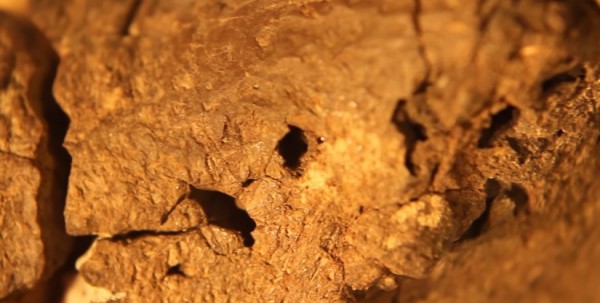By Ana Verayo, | November 01, 2016

Detail of an unassuming brown pebble, found more than a decade ago by a fossil hunter in Sussex, has been confirmed to be the first example of fossilized brain tissue from a dinosaur. (YouTube)
Scientists have confirmed that a fossilized dinosaur specimen is apparently a small piece of dinosaur brain. This specimen was discovered in Sussex, England a decade ago and is estimated to be 133 million years old.
Researchers from Cambridge University say that this precious dinosaur specimen is believed to have originated from a species of Iguanodon. However, scientists say that it is still unclear how intelligent this dinosaur was despite this discovery.
Like Us on Facebook
Brain tissue decays fast. However this dinosaur apparently fell into a bog that preserved its organs with highly acidic and low oxygen water.
According to Alex Liu from the Department of Earth Sciences in Cambridge, chances of dinosaur brain preservation is incredibly small, making this specimen discovery astonishing.
In this new study, researchers scanned this dinosaur brain using an electron microscope and identified brain meninges that were surrounding the specimen.
Scientists have identified striking similarities between dinosaur brain and the brains of birds and crocodiles, that are all descendants of dinosaurs, surviving the Earth's last mass extinction event that wiped out dinosaurs about 65 million years ago.
According to David Norman of Cambridge University, we cannot see the lobes of the brain itself, and we also cannot calculate the exact size of the dinosaur's brain from this specimen alone.
Modern reptilian brains are usually shaped like a sausage where half of it are composed of blood vessels and sinuses.
However, in this case, this fossilized brain appeared to be directly pressing against the skull, suggesting it is a bigger dinosaur brain than previously thought.
Despite this, researchers say that it is most likely that at this dinosaur's moment of death, its head was upside down in the bog. This means that the skull was upside down and as the brain decayed, it collapsed into the top skull.
This new study was published in journal of the Geological Society of London.
-
Use of Coronavirus Pandemic Drones Raises Privacy Concerns: Drones Spread Fear, Local Officials Say

-
Coronavirus Hampers The Delivery Of Lockheed Martin F-35 Stealth Fighters For 2020

-
Instagram Speeds Up Plans to Add Account Memorialization Feature Due to COVID-19 Deaths

-
NASA: Perseverance Plans to Bring 'Mars Rock' to Earth in 2031

-
600 Dead And 3,000 In The Hospital as Iranians Believed Drinking High-Concentrations of Alcohol Can Cure The Coronavirus

-
600 Dead And 3,000 In The Hospital as Iranians Believed Drinking High-Concentrations of Alcohol Can Cure The Coronavirus

-
COVID-19: Doctors, Nurses Use Virtual Reality to Learn New Skills in Treating Coronavirus Patients







